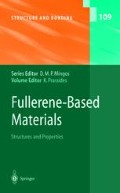Abstract
The most significant developments of recent years on organofullerene materials are presented in this comprehensive review. With selected examples chosen from the current literature, original and well-established synthetic protocols utilizing mainly addition and cycloaddition reactions that have been successfully applied to fullerenes, are discussed. Among these, 1,3-dipolar cycloadditions, Bingel cyclopropanations, and various [2+2], [3+2], and [4+2] cycloadditions are the most useful reactions and have been widely applied for the construction of novel organofullerene materials. Emphasis is also given to the applications of these materials in diverse fields varying from nano- to biotechnological areas, and from the construction of plastic solar cells and optical limiting glasses to DNA photocleavage, magnetic resonance imaging (MRI) agents, and quantum computing.

Preview
Unable to display preview. Download preview PDF.
Author information
Authors and Affiliations
Corresponding authors
Editor information
Rights and permissions
About this chapter
Cite this chapter
Tagmatarchis, N., Prato, M. Organofullerene Materials. In: Prassides, K. (eds) Fullerene-Based Materials. Structure and Bonding, vol 109. Springer, Berlin, Heidelberg. https://doi.org/10.1007/b94377
Download citation
DOI: https://doi.org/10.1007/b94377
Published:
Publisher Name: Springer, Berlin, Heidelberg
Print ISBN: 978-3-540-20106-9
Online ISBN: 978-3-540-39821-9
eBook Packages: Springer Book Archive

